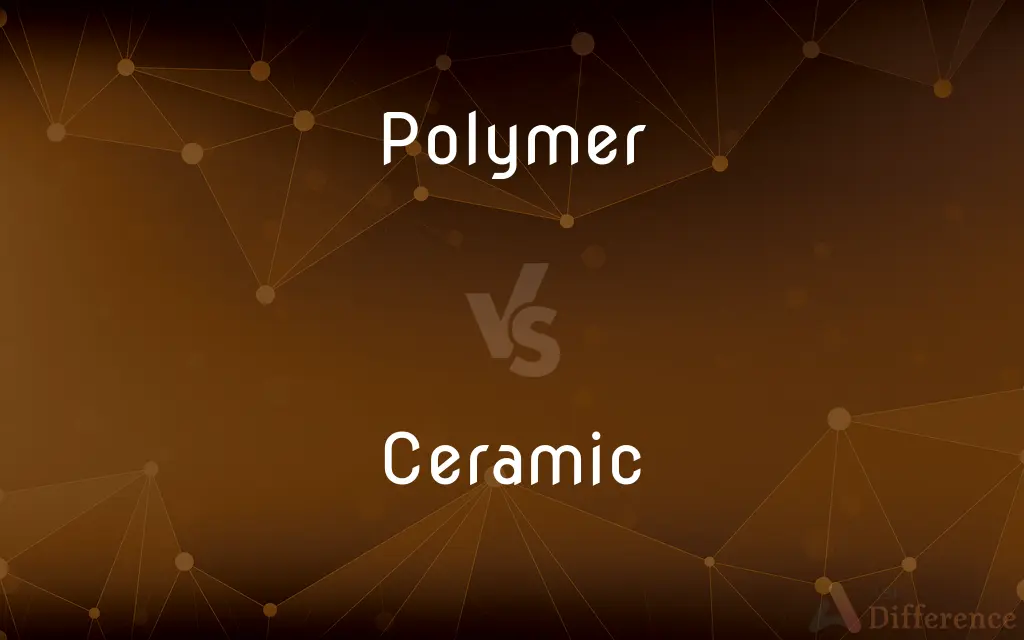Polymer vs. Ceramic — What's the Difference?
By Maham Liaqat & Urooj Arif — Updated on March 10, 2024
Polymers are large molecules composed of repeating structural units, while ceramics are non-metallic, inorganic solids that are typically hard, brittle, and heat resistant.

Difference Between Polymer and Ceramic
Table of Contents
ADVERTISEMENT
Key Differences
Polymers are substances made up of long chains of molecules, known for their versatility and a wide range of applications, from plastics and rubbers to DNA and proteins in living organisms. They can be natural or synthetic and are characterized by their malleability and the ability to be molded into various shapes. Ceramics, on the other hand, are primarily made from clay, silicates, oxides, and non-organic minerals, undergoing a heating process (firing) to achieve their hard, durable, and often heat-resistant properties, making them ideal for applications in pottery, construction, and advanced engineering materials.
The properties of polymers and ceramics significantly differ; polymers are often lightweight, with varying degrees of flexibility and strength depending on their composition and structure. They can be thermoplastic or thermosetting, meaning they can be heated and reshaped or remain permanently set after heating, respectively. Ceramics exhibit high melting points, exceptional hardness, and chemical stability, but are typically brittle and can fracture under tensile stress. This brittleness limits their use in applications requiring high flexibility or impact resistance.
In terms of electrical conductivity, polymers are generally insulators but can be modified to conduct electricity in some cases, such as in the development of conductive polymers. Ceramics include insulators, semiconductors, and superconductors, with applications ranging from electrical insulators in household appliances to components in semiconductor devices and superconducting magnets.
Thermal properties also distinguish polymers from ceramics. While polymers may degrade or melt at high temperatures, ceramics can withstand very high temperatures, making them suitable for use in high-temperature environments, such as in furnace linings, spacecraft, and as thermal insulators.
Environmental considerations and sustainability issues related to both materials are increasingly important. Polymers, particularly synthetic plastics, pose significant environmental challenges due to their non-biodegradable nature and contribution to pollution. Efforts are underway to develop more sustainable and biodegradable polymers. Ceramics, being inorganic and often made from abundant natural materials, generally have a lower environmental impact, although the energy-intensive production process for some advanced ceramics can also raise environmental concerns.
ADVERTISEMENT
Comparison Chart
Composition
Long chains of repeating molecules
Non-metallic, inorganic materials
Properties
Flexible, moldable, variable strength
Hard, brittle, heat resistant
Electrical Conductivity
Generally insulators, some conductive variants
Range from insulators to superconductors
Thermal Properties
Sensitive to heat, can degrade or melt
High temperature resistance
Applications
Plastics, rubbers, fibers
Pottery, construction materials, advanced engineering materials
Environmental Impact
Significant concerns, especially with non-biodegradable plastics
Lower impact, but production can be energy-intensive
Compare with Definitions
Polymer
Composed of long molecular chains.
Polyethylene is a widely used synthetic polymer.
Ceramic
Made from non-metallic, inorganic materials.
Porcelain is a type of ceramic made from kaolin.
Polymer
Environmental concerns.
Plastic pollution is a major issue with synthetic polymers.
Ceramic
Generally lower environmental impact.
Ceramics, made from natural materials, often have a smaller environmental footprint.
Polymer
Temperature sensitive.
Many polymers soften or melt when heated.
Ceramic
Hard and heat resistant.
Ceramics are used for tiles and cookware due to their durability.
Polymer
Versatile and widely used.
Polymers are essential in manufacturing toys, containers, and clothing.
Ceramic
Brittle.
Ceramic materials can break easily under impact.
Polymer
Electrical insulators.
Polymers are used as insulation materials in electrical wiring.
Ceramic
Varied electrical properties.
Some ceramics are used as superconductors in advanced electronics.
Polymer
A polymer (; Greek poly-, "many" + -mer, "part") is a substance or material consisting of very large molecules, or macromolecules, composed of many repeating subunits. Due to their broad spectrum of properties, both synthetic and natural polymers play essential and ubiquitous roles in everyday life.
Ceramic
A ceramic is any of the various hard, brittle, heat-resistant and corrosion-resistant materials made by shaping and then firing a nonmetallic mineral, such as clay, at a high temperature. Common examples are earthenware, porcelain, and brick.
Polymer
Any of numerous natural and synthetic compounds of usually high molecular weight consisting of up to millions of repeated linked units, each a relatively light and simple molecule.
Ceramic
Made of clay and permanently hardened by heat
A ceramic bowl
Polymer
(organic chemistry) A long or larger molecule consisting of a chain or network of many repeating units, formed by chemically bonding together many identical or similar small molecules called monomers. A polymer is formed by polymerization, the joining of many monomer molecules.
Ceramic
Pots and other articles made from clay hardened by heat
Many of the painted ceramics are of native manufacture
Polymer
A material consisting of such polymer molecules.
Ceramic
Any of various hard, brittle, heat-resistant and corrosion-resistant materials made by shaping and then firing a nonmetallic mineral, such as clay, at a high temperature.
Polymer
Any one of two or more substances related to each other by polymerism; specifically, a substance produced from another substance by chemical polymerization.
Ceramic
An object, such as earthenware, porcelain, or tile, made of ceramic.
Polymer
A naturally occurring or synthetic compound consisting of large molecules made up of a linked series of repeated simple monomers
Ceramic
Ceramics (used with a sing. verb) The art or technique of making objects of ceramic, especially from fired clay.
Ceramic
Made of material produced by the high-temperature firing of inorganic, nonmetallic rocks and minerals.
A ceramic vase stood on the table.
Ceramic
(uncountable) A hard, brittle, inorganic, nonmetallic material, usually made from a material, such as clay, then firing it at a high tempature.
Joan made the dish from ceramic.
Ceramic
(countable) An object made of this material
Joe had dozens of ceramics in his apartment.
Ceramic
Of or pertaining to pottery; relating to the art of making earthenware; as, ceramic products; ceramic ornaments for ceilings.
Ceramic
An artifact made of hard brittle material produced from nonmetallic minerals by firing at high temperatures
Ceramic
Of or relating to or made from a ceramic;
A ceramic dish
Common Curiosities
What defines a ceramic?
Ceramics are non-metallic, inorganic solids known for their hardness, brittleness, and heat resistance.
Why are ceramics considered brittle?
Ceramics are considered brittle because they lack the ability to deform under stress, leading to fractures or breaks instead of bending.
How do the applications of polymers and ceramics differ?
Polymers are used in a wide array of products, including everyday items and high-tech applications, due to their malleability. Ceramics are used in applications requiring durability, heat resistance, and electrical properties, such as in construction, pottery, and advanced electronics.
Do ceramics have any role in electronics?
Yes, ceramics play critical roles in electronics as insulators, semiconductors, and superconductors, used in various components and devices.
Are all polymers plastic?
While all plastics are polymers, not all polymers are plastics. Polymers also include natural substances like DNA and synthetic materials with different properties and uses.
Can polymers be environmentally friendly?
While traditional synthetic polymers pose environmental challenges, efforts to develop biodegradable and more sustainable polymers are ongoing.
How do the electrical properties of polymers and ceramics differ?
Polymers are typically insulators but can be made conductive, whereas ceramics range from insulators to superconductors, offering a broad spectrum of electrical applications.
What are the main environmental concerns with ceramics?
The main environmental concerns with ceramics involve the energy-intensive production process, though they generally have a lower impact compared to synthetic polymers.
What are polymers?
Polymers are large molecules composed of repeating structural units, known for their versatility and wide range of applications.
Is it possible to combine polymers and ceramics?
Yes, polymers and ceramics can be combined to create composite materials that leverage the properties of both, used in advanced engineering and medical applications.
What efforts are being made to address the environmental impact of polymers?
Research is focused on developing sustainable polymers, recycling methods, and biodegradable alternatives to reduce pollution and waste.
Can the brittleness of ceramics be mitigated?
Advanced manufacturing techniques and material engineering can mitigate the brittleness of ceramics, enhancing their toughness for broader applications.
Can ceramics conduct electricity?
Some ceramics can conduct electricity, including semiconductor ceramics and superconducting materials, despite many being used as electrical insulators.
What advancements are being made in polymer technology?
Advancements in polymer technology include the development of conductive polymers, biodegradable plastics, and improved recycling processes, expanding their applications and reducing environmental impact.
How does the thermal resistance of polymers compare to ceramics?
Ceramics have much higher thermal resistance than polymers, making them suitable for high-temperature applications, while polymers are more heat sensitive.
Share Your Discovery

Previous Comparison
Grueling vs. Gruelling
Next Comparison
Transport vs. TransportationAuthor Spotlight
Written by
Maham LiaqatCo-written by
Urooj ArifUrooj is a skilled content writer at Ask Difference, known for her exceptional ability to simplify complex topics into engaging and informative content. With a passion for research and a flair for clear, concise writing, she consistently delivers articles that resonate with our diverse audience.















































